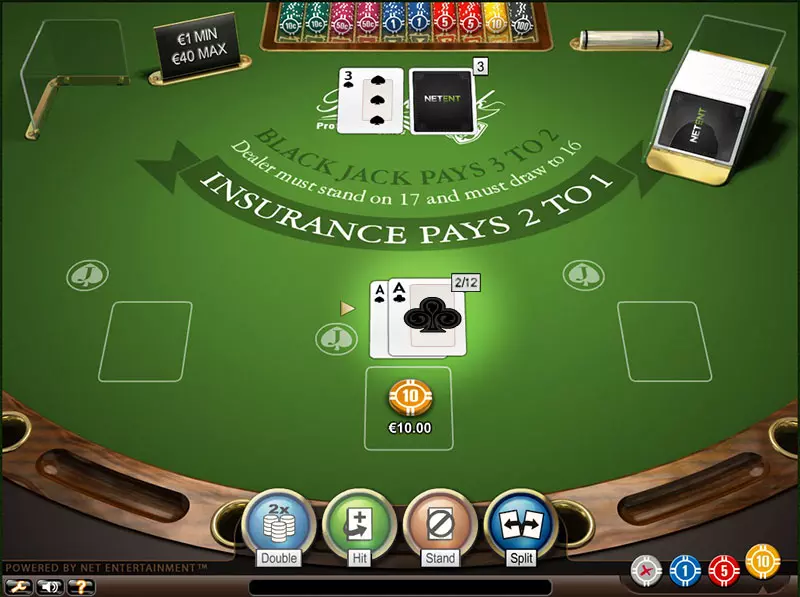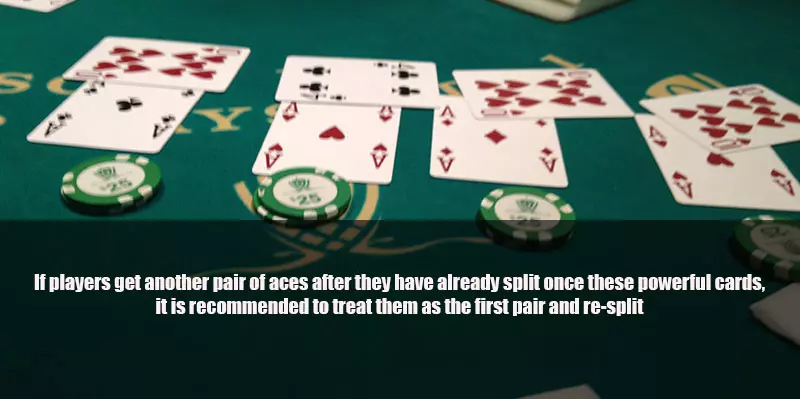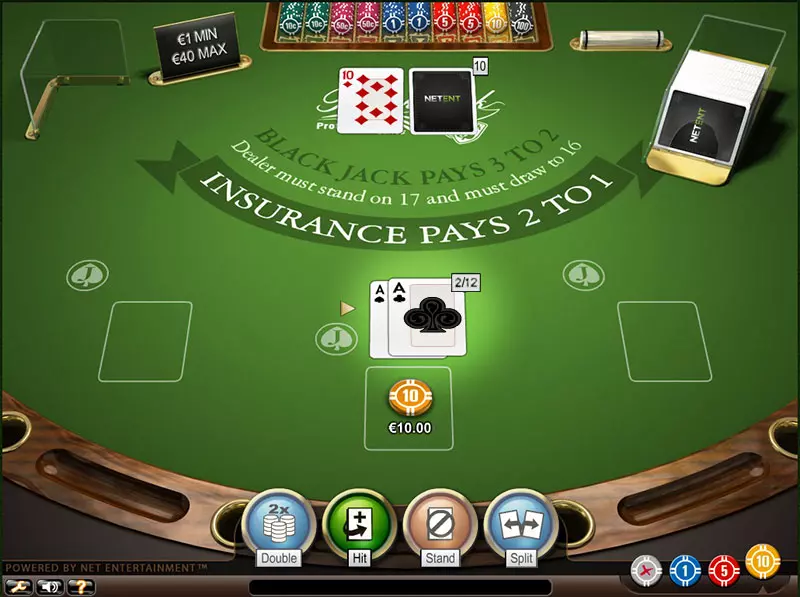Blackjack is a casino game that requires much more than just luck which is the reason why it is popular among players all over the world. Even though most of them are familiar with its basic rules, they usually are not aware of all the possible outcomes a particular move can lead to. Thus, they fail to make the right decision in tough situations and often lose a sequence of hands.
To make the matters worse, many players don’t follow any strategy and decide how to proceed at the moment of playing. Of course, not following any pattern, their choices are different each time which doesn’t allow them to see their mistakes as there is no record of their decisions. This is the reason why it is extremely important to follow a strategy and know what the possible outcomes of a particular move are.
In this chapter, we will have a closer look at situations where players have pairs of aces in their hand and whether they should be split every time. The ace in blackjack is the most powerful card and as such, whenever players receive it, they need to make the best possible move to benefit from it.
This is why it is really important to observe all of the cases where they can get not one but two such powerful cards. Players need to realise that a pair of aces gives them an incredible power and places them in a very advantageous position.
Important Things To Consider
Just like on any other occasion in order to make the best possible move, players need to take into account the total value of their hand and the dealer’s upcard. On the bright side, the basic strategy for a pair of aces is incredibly easy to commit to memory because it is not impacted by playing conditions like deck number and the rules the dealers are bound to stick to.
There is only one correct playing decision for this hand according to basic strategy and it is to split. Exceptions are made only for blackjack variations of the European style where no hole cards are involved but more on this later.
Players need to bear in mind that having two aces gives them the opportunity to win only if they make a reasonable move. Even such a beneficial hand can result in going bust if players misplay it. It is especially important for players to know how to proceed in such cases as they have two of the most powerful cards in the game and making a bad decision is just a missed opportunity to make more money.
But why are aces so important in the game of 21? The answer lies in the bespoke flexibility this card has in blackjack. Aces are the only cards in the game that can change their value depending on the player’s preferences and the cards drawn to their hand. You can count them as 1 or 11 at your discretion.
Aces are the real pillars of this game since they also enable you to form blackjacks, which produce a bonus payout of 3 to 2. A blackjack inevitably trumps any total a dealer might have unless it, too, is a blackjack. Another benefit that stems from the ace’s flexibility is that it allows you to form soft hands.
These are impossible to break with a single-card draw. This translates in more opportunities for successful doubling down. In fact, nearly half of the basic strategy plays for double downs involve soft doubles.
The strength of the ace is two-fold, meaning that this card also helps the house. A dealer is at an advantage when they start a hand with an ace. When this happens, their probability of drawing to a pat 19 in a standard six-deck S17 game is rather decent at 18.89% while that for reaching pat 20 is even higher at 18.93%.
| Ace-Ace Basic Strategy Chart for Hole-Card US-Style | ||||||||||
|---|---|---|---|---|---|---|---|---|---|---|
| Player’s Hand | Dealer’s Upcard | |||||||||
| 2 | 3 | 4 | 5 | 6 | 7 | 8 | 9 | 10 | Ace | |
| A-A | S | S | S | S | S | S | S | S | S | S |
Splitting Pairs of Aces
Let’s have a look at the possibilities of the dealer’s upcard and how players should proceed in particular cases. If they find themselves in a situation where the upcard of the dealer is from 2 through ace, their best move is to split. This is always the case across all American-style blackjack variations that use hole cards without regard to the number of decks or the dealer rules.
Aces put players’ in a very favourable position that is worth taking full advantage of it in the best possible way. Whenever players split aces, they need to take into account that they get only one card for each ace and that the average winning hand is 18.5. A pair of aces results in a soft total with a flexible value of either 2 or 12. Neither of these starting totals is particularly strong for the player. Both common sense and basic strategy favour a split since this move gives players the chance to start two promising hands with a strong total of 11 rather than soft 2/12.

Unlike splitting 8s, which is a defensive move, the splitting of paired aces is an offensive approach since it enables the player to convert one mediocre total into two powerful hands that stand decent chances of beating the dealer. Regardless of what dealer upcard you are facing, splitting your aces imminently gives you positive expected value and allows you to capitalise on your advantageous position.
Some players have an aversion toward splitting aces since a split requires them to put up an extra bet to cover the second hand. And sure enough, you will not always beat the dealer when you split this pair. Occasionally it will happen so that you catch another ace or a small card that gets you stuck with a weak hand total.
Nevertheless, this is the most mathematically optimal move you can exercise since it gives you the highest profits in the long-term. No other playing decision is as powerful as the split when one is holding aces. One peculiarity about splitting this particular pair is that generally, casinos prohibit you from hitting or resplitting them.
Instead, the dealer is instructed to give only one more card to each of the split aces. Such restrictions only confirm the powerful situation starting with an ace puts the players in. Let’s see how splitting performs against the dealer’s 5 compared to the other playing decisions like standing or hitting. The expectation values listed are accurate for shoe games where the dealer is forced to stand on soft 17.
| EV for Plays for A-A against the Dealer’s 5 in Multiple-Deck S17 Blackjack | |
|---|---|
| Splitting | +0.614699 |
| Hitting | +0.156482 |
| Standing | -0.167193 |
| Doubling | +0.125954 |
As is plain to see, probability favours splitting since it leads to the highest long-term profits for the player. Splitting the aces earns you around 46 pence more per pound wagered compared to hitting, 45 pence more than standing, and 49 pence more than doubling. No matter how you look at it, this is the most optimal play.
The above tendencies are to be observed against all dealer upcards in hole-card blackjack, not only against the weak 5. Where rules are concerned, there are always exceptions, though. The only case in which basic strategy favours hitting aces over splitting them is in European-style blackjack where no hole cards are in play.
When at an ENHC table, you should always split the aces versus dealer upcards deuce through 10, and hit your soft 12 against the dealer’s ace. The dealer standing or drawing to S17 is irrelevant in this instance.
| A-A Basic Strategy for ENHC Blackjack | ||||||||||
|---|---|---|---|---|---|---|---|---|---|---|
| Player’s Hand | Dealer’s Upcard | |||||||||
| 2 | 3 | 4 | 5 | 6 | 7 | 8 | 9 | 10 | Ace | |
| Soft 12 (A-A) | S | S | S | S | S | S | S | S | S | H |
Re-Splitting
If players get another pair of aces after they have already split once these powerful cards, it is recommended to treat them as the first pair and re-split. Players need to remember that they should apply their strategy every time they have a particular card combination, in this case – two aces. It is worth mentioning that if gamblers do so and re-split, they need to triple their initial bet, whereas the first time they split, it was only needed to double it.
Also, players need to bear in mind that the game rules for splitting and re-splitting may vary. Thus, they need to get familiar with them beforehand. Some casinos allow only a certain number of splitting and others don’t allow re-splitting at all.

Different Casino Rules for Splitting Paired Aces
Casinos know full well how vital aces are in blackjack so the most logical thing for them to do is try and offset some of the advantage this powerful card gives to the player. Various restrictions are in place when players are dealt a pair of aces. Below, we describe some of the different casino rules that apply to playing pairs of aces.
- Resplitting aces is often disallowed in both landbased and online blackjack. This is not the case with other pairs which usually can be resplit to form up to four hands. This makes perfect sense considering resplitting aces adds roughly 0.08% to the players’ advantage.
- Hitting split aces is usually also prohibited as it yields an advantage of 0.19% for the player in multiple-deck blackjack. Regrettably, most gambling venues and online casinos allow only a single card to be drawn next to each split ace. Very few would allow you to draw more cards under such circumstances.
- A ten-value card drawn to a split ace usually counts as a regular total of 21 and does not count as a blackjack. Therefore the player receives even money in such cases rather than being paid at odds of 3 to 2. Had this been the case, the casino advantage would have decreased by 0.21%. Even the reduced payout of 6 to 5 would have caused a 0.11% drop in the house edge in such instances.
- Splitting aces is altogether disallowed at some blackjack tables, which increases the house edge by 0.18%. Our advice is to do your best to avoid such games, when possible.
- Discarding split aces is a very rare rule, allowing you to give up one of your two hands following the split. A different approach is required under this rule as the player needs to also learn the strategy for when to throw away their hand.
- Splitting aces you have drawn to is another rule you can find once in a blue moon. Needless to say, very few casinos would actually permit this. If applicable, the only condition is for the aces to be dealt directly next to each other like A-A-3 or 3-A-A rather than A-3-A. The splits are then played as normal.
Splitting a Pair of 2’s or 3’s
Splitting a Pair of 4’s
Splitting a Pair of 5’s
Splitting a Pair of 6’s
Splitting a Pair of 7’s
9, 10 or an Ace as the Dealer’s Upcard
Some gambling authors, who shall remain unnamed, suggest that blackjack players should not split paired aces in some cases. To be more specific, said authors recommend against splitting this pair when the dealer has high upcards 9, 10, or ace.

The “logic”, for lack of a better word, is that splitting aces against high upcards puts players in a disadvantageous position. They risk getting stuck with small cards (remember hitting split aces is normally disallowed) and being outdrawn by the dealer, who is in very good shape when showing 9 through ace. Hitting is recommended instead.
We regret to say this piece of advice is nothing but hogwash. The only exception to the “always split aces” rule is against the dealer’s ace in ENHC blackjack. Period. Experts and mathematicians alike have proven time and time again that aces should always be split against all upcards.
Recognized blackjack expert Michael Shackleford has estimated the exact expectation each move yields against these upcards. The figures are accurate for variations where the S17 rule applies. Nevertheless, splitting aces against everything is optimal across all hole-card variations of the game.
| EV of A-A vs. the Dealer’s High Upcards 9 through Ace in S17 Games | |||||
|---|---|---|---|---|---|
| A-A vs. 9 | A-A vs. K, Q, J, 10 | A-A vs. Ace | |||
| Splitting | 0.227783 | Splitting | 0.179689 | Splitting | 0.109061 |
| Hitting | 6.6E-05 | Hitting | -0.070002 | Hitting | -0.020478 |
| Standing | -0.54315 | Standing | -0.54043 | Standing | -0.666951 |
| Doubling | -0.456367 | Doubling | -0.514028 | Doubling | -0.624391 |
This move has been proven to produce the highest expectation for the player by probability theory. Computer simulations further solidify its accuracy and efficiency. Splitting is clearly optimal against these cards since it produces the highest long-term winnings. Our advice is to be careful when choosing blackjack literature, especially if you are completely new to the game and are just learning the basics.
Conclusion
The only way players can become consistent winners in blackjack is to know how to play every single hand they have. There isn’t a strategy that guarantees they will win inevitably all the time. In fact, on many occasions two different moves are possible and each one would lead to a different outcome.
Gambling includes taking risks and when money is involved, it is up to the players to decide whether they would like to reduce their monetary losses to the minimum. It is possible when playing blackjack as it is a game of skills and as such, they can significantly make a difference if prepared beforehand. It is really important for players to follow a strategy which they support themselves and find reasonable enough.
Otherwise, they won’t understand the whole idea behind it and it will be very hard to apply it without making any sense. Having two aces in their hand is a great way to gain an advantage over the casino only if they know how to proceed in such a situation.